I first thought of this question last summer when I was passed on a recipe for pita breads that required making a 2 hour sponge first, it asked you to mix flour, water and yeast leave for 2 hours before adding the rest of the ingredients. I wondered why you had to do it but stored it at the back of my mind for the time being. That was until I came across Dan Lepard’s Soft Baps recipe which asks for a 3 hour sponge. Now I was really intrigued. Why do this extra step in making a yeast bread? At first with Dan’s recipe I thought it was because of adding fat as fats can inhibit gluten development but then someone pointed out on the Fresh Loaf Forum the fat quantity wasn’t that much to worry about.
When I was working on my Why Does My Pastry Shrink? post I remembered reading in How Baking Works by Paula Figoni in the pastry section that fats inhibit gluten development by acting as a barrier coating the surface of the flour stopping it absorbing water which is the process for gluten development. You need a high proportion of fat for that to happen and a member, David on the Fresh Loaf forum pointed out Dan’s recipe was only 9% fat where rich doughs requiring you to treat them a little different can have 40-70% fat.
If like me you’re just starting on the road of breadmaking then it can be quite confusing coming across terms like sponge, biga, poolish, pre-ferment, though I think pre-ferment is self explanatory. Wiki covers them here, another good term is pate fermentee which I’ve read referring to as old dough but Wiki puts it together in the same context as pre-ferments, that to me just confuses things. Old dough was literally what my Gran used for making her Broa recipe. All of these terms I read it’s about developing flavour, texture too but the word flavour gets bounced a lot with this and usually within the context of sourdough.
Longer process in making sourdough and developing flavour makes sense to me. I’m not experienced with these methods for sourdough but I do know from my own experience of baking Dan’s white sourdough often that delay of any sorts seems to result in stronger tasting sourdough. Retarding the loaf in the fridge develops a sourer tasting loaf. I found the same with using a starter you have fed a few hours ago to using one you’ve fed 24-36 hrs previously, the older one will result in a slightly sourer tasting bread. I’m sensitive to these changes because I’m used to the same loaf unadulterated, like anything your tastebuds gets accustomed to it and notes change.
Using a short time sponge in a yeast recipe I didn’t understand why because I couldn’t taste a more flavoursome bread. I asked around the forums and received some useful opinions on The Fresh Loaf as to why, opinions varied from some flavour development to gluten development. The member David ended up making Dan’s Soft Baps and was so pleased with them it was a keeper recipe for him, you can see his photos here.
I was still none the wiser, flavour or gluten development, maybe both. I made the pita bread recipe using the 2 hour sponge about four times and could not detect a more flavoursome pita. I make pitas now every other week, simply throw it all in and if I want to add flavour I’ll add a bit of my sourdough starter with the yeast. I made Dan’s baps recipe as rolls 3 times and then as a loaf twice could not taste a more flavoursome bread…maybe I’m missing the subtle flavour gene to detect extra flavour in a yeast loaf using a sponge method. It was time for a side by side trial.
I explain in detail about making this recipe into a loaf in the post here. To summarise I’ve been searching for a really soft bread recipe for allergy daughter for months now…she adores soft crumb to the point she’ll prefer shop bought bread to homemade bread…I know…what can I say? I obviously make lousy bread!
With all seriousness it’s hard to get really soft crumb loaf and make it allergy friendly for her but managed it brilliantly with this recipe. I turned the baps into a loaf trying to cut on time and convenience and discovered this bread made good toast for allergy daughter. This bread had now become her breakfast loaf and at this point I decided to make two batches side by side, one using the 3 hour sponge and the other my lazy way of throwing it all in method.
In this post you have photos from more than one batch of side by side trials. Some of the photos are of batches I neglected the sponge and dough for 7 hours because kids got in the way and was surprised to see both loaves still baked well no problems, though I suspect this was only because it was winter and not during a hot summer’s day.
In the photo below I have to the left the loaf made with the 3 hour sponge and to the right the all-in-one method.
I left them to prove both for the same amount of time, 3 hours, finishing the doughs and left them in the tin for 30-40 mins for second rise until the dough came above the brim of the tin. Baked without steam.
What Was the Difference Between the Two?
As soon as I cut into the loaves to slice it it became really clear the difference; texture. This is where there should be feel photography because looking at them it’s difficult to tell the difference. I gave the different slices for people to tell me if they detected any flavour difference and no one did, but the texture was obvious. The 3 hour sponge has a chewier texture the all-in-one a much softer crumb.
Looking back at David’s photos from the Fresh Loaf forum he comments on his rolls having a “very slightly chewy” texture and that’s what I get from my 3 hours sponge loaf.
Fantastic for making a choice, when making the bread for the likes of me who wants texture in a bread I can use the 3 hour sponge method but when making it for soft crumb obsessed allergy daughter the throw-it-all-in is the way to go.
Photos
In the photos below you have the 3 hours sponge method, mixing flour, water and yeast.
Below it’s the throw it all in and leave it for the same amount of time, 3 hours.
Photographed after just over an hour, they both rising well.
This batch below is the all-in-one loaf having neglected it for 7 hours…lot’s of airy pockets and very stringy.
Still produced a good loaf.
The batch of photos below are from my last trial of doing side by side this Saturday, and it’s the second batch I neglected for 7 hours, the colour of the bread is because I had to take the photos using the kitchen lights since my daylight had gone.
Left slice is the 3 hour sponge. Right is the all-in-one loaf.
Below all-in-one method loaf.
Below 3 hour sponge loaf.
I normally like to bake my loaves dusted with flour, think they look prettier than without.
I Answered One Question but I’m Left with a Different One
This is what happens with bread, it brings up more questions.
Why does the all-in-one loaf rise more than the 3 hour sponge loaf?
It doesn’t matter if I leave it for the required 3 hours or if I neglect them for 7 hours, the result is the same.
I’ve been thinking about this all weekend. From doing my Bronze Pasta post my memory recalls the roles Gliadins and Glutenins play in the dough which McGee talks about, I cut and paste from that post when I first understood how gluten worked:
These gluten proteins are mainly gliadins and glutenins which are about a thousand amino acids long. The gliadin and glutenin chains play different roles; gliadin chains, “…fold onto themselves in a compact mass, and bond only weakly with each other and with the glutenin proteins. Glutenins, however, bond with each other in several ways to form an extensive, tightly knit network”.
….and some of these chains are weak, and because they are weak when you work the dough some of the chains brake allowing the dough to be manipulated but the chains that don’t brake spring back, this is why you have the dough being responsive. Now I know proteins in wheat contain gliadins and glutenins, one producing a weak chain and the other a tighter chain, which helps when making dough. According to McGee the whole point of this protein in bread flour is so it becomes elastic making possible to change the shape as you work with it but yet resists the pressure and moves back to its original shape when pressure is removed.
When you’re adding the rest of the ingredients to the 3 hour sponge you’re having to work them into the dough to get the sponge to absorb the extra liquid and fat and the rest of the flour, so I figure the work the proteins have done in the 3 hour sponge plus the working again of mixing the rest of the ingredients, does it just tire out the proteins too much?



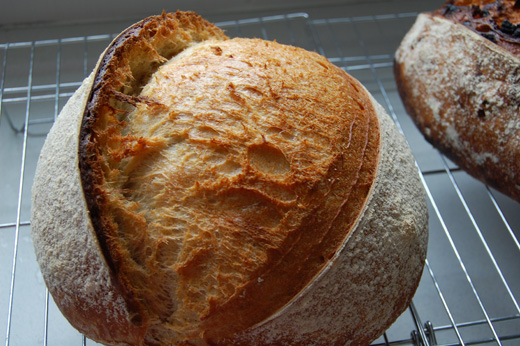

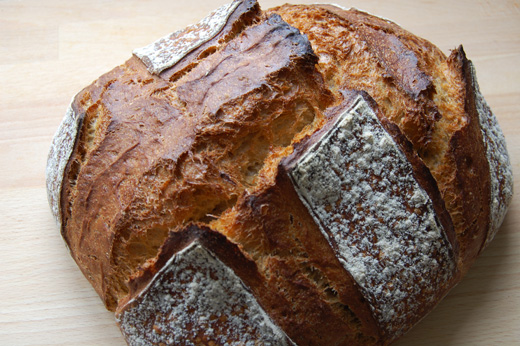






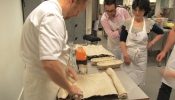














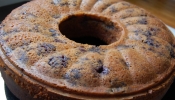


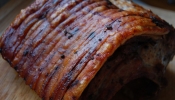



{ 8 comments… read them below or add one }
Hey Azelia,
Hard to believe that you’re using the same amount of dough for both loaves! The no sponge loaf just looks bigger. I can’t even see that the air pockets in the no sponge are bigger, or that there are more of them, but then I’ll bet trying to determine that from a photo is difficult. However, there may be something with the fact that the 3 hour sponge dough is pushing the limits of how long the commercial yeast will keep aggressively working – it may just be getting tired.
If you think the difference is texture, then gluten is the reason – we know that gluten develops three ways: when liquid is added, when physically moved (kneaded), and over time (3 hour sponge). Interesting that you didn’t notice any flavor development with the 3 hour sponge – but then, I doubt you get the same result from a ferment with commercial yeast that you get with sourdough.
Have you ever gone on Dan’s website? He’s very approachable, and as of a few years ago (I haven’t been back lately), he was quite involved with answering many questions there – you could just ask him.
I love the way you grab these issues and run with them – a very nice post, Azelia. Thanks for an interesting read.
hi dr fugawe – well we have mutual appreciation society going on as you know you provide me with interesting reading at all sorts of hours of the night!
Yes to me it comes down to commercial yeast being tired with the 3hr sponge. I’m yet to find a white plain loaf using commercial yeast that tastes flavoursome..unless stuff is added to it. I think this is the curse of sourdough bakers, once you taste the wild stuff hard for commercial yeast to compete.
This is a great post. I’ve made Dans soft bap recipe countless times but never questioned the need for a sponge. This explains why these baps hold together so well for bbq’d sausages and burgers… Thanks!
hi Luc – they’re going to be this summer bbq burger rolls for me too…since they’re soft and can be dairy-free…yeah that Dan can make a good roll
Really great post, Azelia!
Not sure what’s going on – the explanation of the yeast getting exhausted (or at least past peak activity) seems plausible, but it’s odd that the 3hr vs 7 hr sponge doesn’t seem to make a difference.
Just looking at pictures of the loaves, it looks like one has opened up the slash more than the other? Maybe there’s something about the hydration?
BTW, I went back to your pastry post today – *such* a great post!
thanks Louise! knowing how you are about things it’s a great compliment.
I wonder if having to knead the liquid and extra flour just exhausts it too much but yes you’re right it makes no odds with the difference between the 3hr or 7hr sponge.
Like the post Azelia. I understand now why pizza in Campania in Italy is made with a small amount of yeast (1-2g) and left for 24 hours (after which you’ll have as much yeast as a shorter prove with more yeast added); it would make it stretchier so you’ll have a thinner base.
How interesting Johnny, stretchier and thinner and able to maintain strength to hold all the ingredients on top…that makes complete sense.
{ 2 trackbacks }